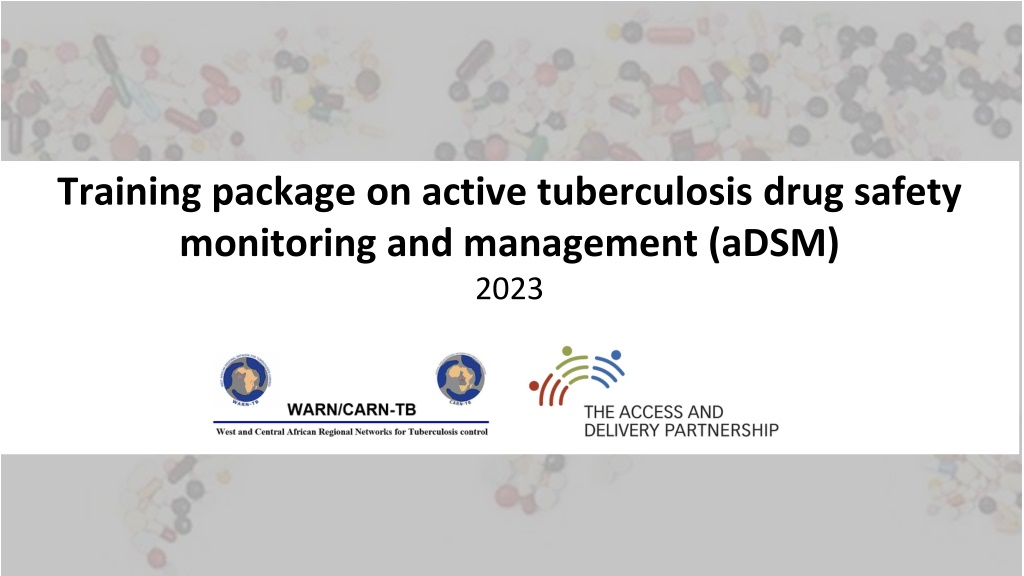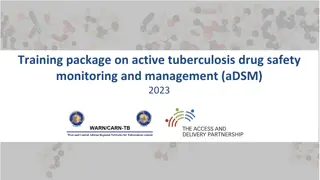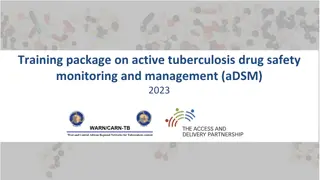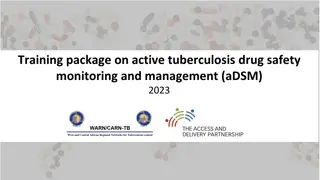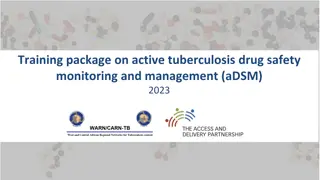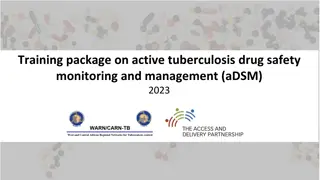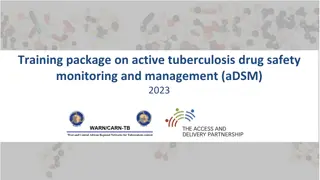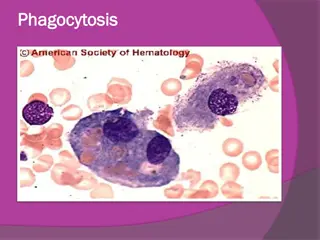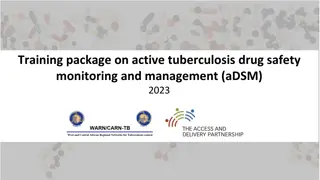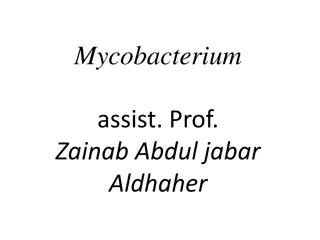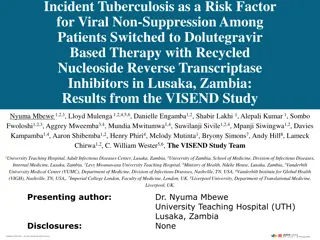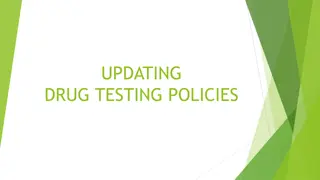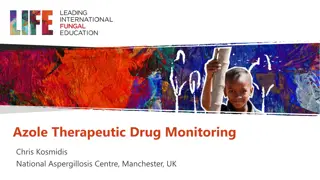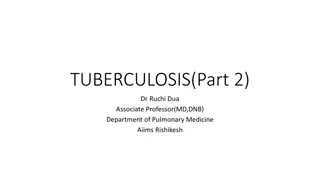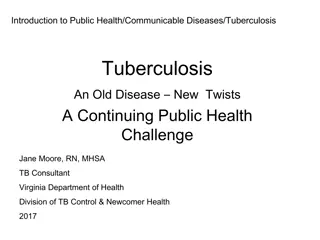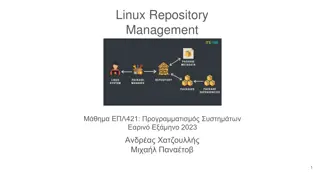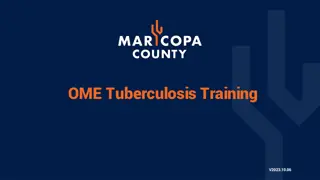Comprehensive Training Package on Active Tuberculosis Drug Safety Monitoring and Management (aDSM) 2023
This training package focuses on providing in-depth knowledge and practical skills for the safety monitoring and management of active tuberculosis drug treatments. It covers essential modules for healthcare workers and managers, including core and complementary topics such as clinical monitoring, adverse event management, data collection, and program implementation. Through structured courses and key references, participants will gain proficiency in implementing aDSM effectively to enhance TB treatment outcomes.
Download Presentation

Please find below an Image/Link to download the presentation.
The content on the website is provided AS IS for your information and personal use only. It may not be sold, licensed, or shared on other websites without obtaining consent from the author. Download presentation by click this link. If you encounter any issues during the download, it is possible that the publisher has removed the file from their server.
E N D
Presentation Transcript
Training package on active tuberculosis drug safety monitoring and management (aDSM) 2023
1.1. Structure and training objectives for this course & key references
Structure of this training packages (1) Background Overview Training pack for heath care workers Training pack for managers Core modules (aDSM in everyday practice) Core modules (Implementing aDSM) Complementary modules Complementary modules
Structure of this training packages (2) Background, Overview, Objectives 1. Training objectives for this course & key references 2. Key definitions 3. Active TB drug-safety monitoring : rationale and mechanisms in the context of TB & MDR-TB treatment
Structure of this training packages (3) Training pack for health care workers 2.Core modules (aDSM in everyday practice) 1. Clinical monitoring and management of adverse events 2. Train staff on the collection of data 3. National and international reporting of adverse events: mechanisms, routes and resources 4. Records Management & Quality Assurance of Data
Structure of this training package (4) Training pack for health care workers 3. Complementary modules (aDSM) 1. Indicators of aDSM implementation and programme management
Structure of this training package (5) Training pack for managers 2.Core modules (Implementing aDSM) 1. The 8 key elements for the implementation of aDSM in a national TB programme i. Create a national coordinating mechanism for aDSM ii.Develop a plan for aDSM iii.Define management and supervision roles and responsibilities iv.Create standard data collection materials v.Train staff on the collection of data vi.Define schedules and routes for data collection and reporting vii.Consolidate aDSM data electronically viii.Develop capacity for signal detection and causality assessment 2. National and international reporting of adverse events: mechanisms, routes and resources 3. Indicators of aDSM implementation and programme management
Structure of this training package (6) Training pack for managers 3. Complementary modules (aDSM) 1. Record management and quality assurance of data 2. Causality assessment: scales & methods 3. Signal detection introduction 4. Overview on risk communication and new knowledge integration 5. Role of national and international technical and funding partners in the implementation of aDSM
Training pack for health care workers training curriculum Targets HCWs in charge of DR-TB patients at peripheral level (DR-TB facilities) clinicians, nurses Focuses on technical components Monitoring, clinical management and reporting of aDSM
Learning objectives for HCWs By the end of the training modules, the participant is expected to be able to 1. Identify and understand the key concepts and definitions of aDSM Correctly identify adverse events and culprit drug(s) during the clinical monitoring of DR-TB treatment Effectively manage adverse drug reactions during treatment Properly record adverse events per system affected and by severity (following standard guidelines) Properly and regularly notify adverse events to NTP or the pharmacovigilance department of the MoH 2. 3. 4. 5.
Training pack for managers training curriculum Targets National TB Programme (NTP) and Pharmacovigilance (PV) management staff at central management level with knowledge of the PV system and DR- TB management in the country Focuses on implementation and coordination aspects for systematic reporting of aDSM to national and international systems causality assessment signal detection and communication
Learning objectives for managers By the end of the training modules, the participant is expected to be able to 1. Identify and understand the key concepts and definitions of aDSM Describe how to implement and manage aDSM within a TB programme Properly summarize AEs and regularly forward results to the pharmacovigilance department of the MoH Understand key concepts of causality assessment, signal detection and safety risk management 2. 3. 4.
https://www.who.int/publications/i/item/WHO-HTM-TB-2015.28 active and systematic clinical and laboratory assessment of patients on treatment with new TB drugs, novel MDR- TB regimens or XDR-TB regimens to detect, manage and report suspected or confirmed drug toxicities https://apps.who.int/iris/bitstream/handle/10665/204465/WHO_HTM_TB_2015.28_eng.pdf?sequence=1&isAllowed=y https://apps.who.int/iris/bitstream/handle/10665/365309/9789240065352-eng.pdf?sequence=1&isAllowed=y
WHO guidance on treatment & management of drug-resistant TB, 1996-2022 2016 2020 2022 WHO consolidated guidelines on tuberculosis. Module 4: treatment - drug-resistant tuberculosis treatment, 2022 update. Geneva: World Health Organization; 2022. WHO operational handbook on tuberculosis. Module 4: treatment - drug-resistant tuberculosis treatment, 2022 update. Geneva: World Health Organization; 2022.
2012 Historically, the first WHO publication specifically focused on the pharmacovigilance of TB medications. Describes spontaneous and active pharmacovigilance; signal detection, causality assessment between an event and a drug, making decisions and communicating findings https://apps.who.int/iris/bitstream/handle/10665/336226/9789241503495- eng.pdf?sequence=1&isAllowed=y
2013 Standardization of definitions and reporting parameters has permitted uniformity in the reporting of performance indicators of national TB programmes for many years https://apps.who.int/iris/bitstream/handle/10665/79199/9789241505345_e ng.pdf?sequence=1&isAllowed=y
Use of bedaquiline and delamanide In adults in children https://apps.who.int/iris/bitstream/handle /10665/332398/9789240006997- eng.pdf?sequence=1&isAllowed=y https://apps.who.int/iris/bitstream/handle/10 665/352523/9789240046832-eng.pdf
August 2014, updated early 2016 https://apps.who.int/iris/bitstream/handle/10665/130918/9789241548809_eng.pdf?s equence=1&isAllowed=y
August 2014, updated 2016 and 2022 https://apps.who.int/iris/bitstream/handle/10665/130918/9789241548809_eng.pdf?sequence=1&isAllowed=y https://apps.who.int/iris/bitstream/handle/10665/365309/9789240065352-eng.pdf
WHO/HTM/TB/2011.22 Adopting electronic recording and reporting is not simply about choosing a piece of software: it is also about changing how people work. This is not a simple undertaking. This document indicates key questions to be considered and illustrates what the questions, options and recommendations mean in practice by drawing on examples of recent experience from a variety of countries. It is useful for those planning to introduce electronic recording and reporting systems for TB care and control, or to enhance existing systems whqlibdoc.who.int/publ ications/2012/9789241 564465_eng.pdf https://apps.who.int/iris/bitstream/ha ndle/10665/259832/9789241513456 eng.pdf?sequence=1&isAllowed=y
WHO/HTM/TB/20 14.09 This book presents the practicalities of standard and advanced analysis of programme TB surveillance data. The same approaches could have an application for in-depth analysis of aDSM data. http://apps.who.int/iris/bitstream/handle/10665/129942/9789241548786 _eng.pdf?sequence=1
Manns Pharmacovigilance, 3rdEdition. Published 2014 by John Wiley & Sons, Ltd.
Acknowledgements The development of the aDSM training material was funded by TDR as part of the Access and Delivery Partnership (ADP) with funding from the Government of Japan. These training materials were put together in 2016 the WHO Task Force on aDSM with technical partners KNCV Tuberculosis Foundation, Management Sciences for Health (SIAPS), MSF, WHO GTB, and TDR. The materials were updated in 2022-23 by Mahamadou Bassirou Souleymane (TDR consultant) with Marie-Eve Raguenaud (TDR), Branwen J Hennig (TDR), and Corinne Merle (TDR), and reviewed by Linh Nhat Nguyen (WHO/GTB), Medea Gegia (WHO/GTB), and Fuad Mirzayev (WHO/GTB). We thank all members of the WARN/CARN-TB working group on aDSM who contributed to the development of the aDSM generic guidelines as well as the secretariat, particularly Dr Christ Houessinon: Disadidi Ambrioso, Esse Marius, Adomou Jamal Rouamba Ruffine, Haro Sougrimani, Koumbem Boureima, Nsanzerugeze Jos lyne, Tollo Tollo Daniel Alphonse D sir , Mpaba Minkat Th ophile Mistral, Julie Abessolo, Ursule IDOKO, Tijan Baldeh , Wandifa Samateh, Tida S Kinteh, Alieu Wurie, Mardemn Yeasuen, Benjamin K. Quenneh, Cheick Oumar Bah, Kane El Hadj Malick, Aw Idriss, Mamoudou Hama Rachida, Gagara I. M. Assiatou, Katamb Balkissa, Seiyabatou ElhSaidou, Liombo Anastasie, Lunganyu Junior, Kitambala Sentime, Lula Yves , Habimana-Mucyo Yves, Migambi Patrick, dos Santos Brigite, Castro V nia, Wadson Cruz, Gueye Aminata, Mukeh Fahnbulleh, Bailor Samuel, Manjo Lamin, Saleh Mahareb Abdoulaye, Haroun Saleh Naima, Mouhoudine Yerima, Kpelafia Silifa
